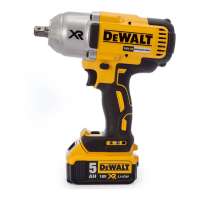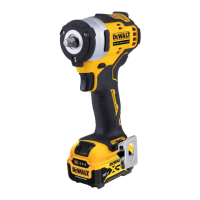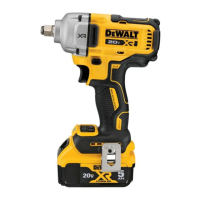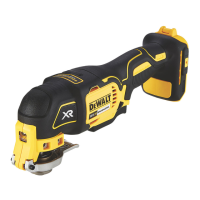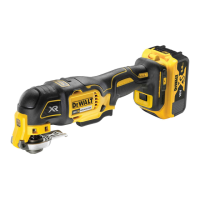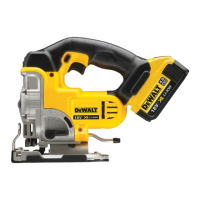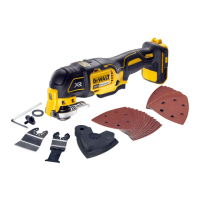11
ENGLISH
Precision Wrench™ Mode (Fig.C)
In addition to low speed impacting modes, this tool features
the Precision Wrench™ mode which grants the user greater
control in both fastening and loosening applications. When set
in forward, the tool will fasten at 2500RPM until impact begins.
The tool will then pause for 0.5 seconds before continuing
to impact at a rate of 3550IPM, providing the user with
greater control and reducing the chance of overtightening or
damagingmaterial.
When set in reverse, the tool will impact at a normal speed and
rate of 3550IPM. Upon sensing that the fastener has broken
free, the tool will cease to impact and will reduce speed to help
prevent “run‑off” of loosehardware.
Timber Screw™ Mode (Fig.C)
DCF922, DCF923
Timber Screw™ mode optimises tool performance to help
increase the speed of fastening applications in wood using lag
bolts, lag screws and structural woodscrews.
Scaffolding Mode (Fig.C)
DCF921
Your tool is equipped with a mode designed for scaffolding
applications. In forwards rotation it will run down the nut on
the scaffold clamp and then impact for a period of time before
cutting off to avoid over tightening of the fastener. In reverse
rotation it will impact to break the nut free, before winding
down the nut and cutting off after a period of time to limit
damage toclamps.
NOTE: Always check scaffolding clamps are tightened correctly
with a torquewrench.
Anvil (Fig.A, D)
WARNING: Use only impact accessories. Non‑impact
accessories may break and cause a hazardous condition.
Inspect accessory prior to use to ensure that it contains
nocracks.
CAUTION: Inspect anvils, detent pins, and hog rings prior
to use. Missing or damaged items should be replaced
beforeuse.
Place the switch in the locked off (centre) position or remove
battery pack before changingaccessories.
Anvil with Detent Pin (Fig.D)
DCF922
To install an accessory on the anvil, align the hole in the side
of the accessory with the detent pin
15
on the anvil
3
. Press
the accessory on until the detent pin engages in the hole.
Depression of detent pin may be necessary to aid installation
ofaccessory.
To remove an accessory, depress the detent pin through the
hole and pull the accessoryoff.
Anvil With Hog Ring (Fig.D)
DCF921, DCF923
To install an accessory on the hog ring anvil, firmly push
accessory onto the anvil
3
. The hog ring
14
compresses to
allow the accessory to slide on. After accessory is installed, the
hog ring applies pressure to help provide accessoryretention.
To remove an accessory, grasp the accessory and firmly pull
itoff.
Specifications DCF922, DCF923
Mode Application RPM
Precision Wrench™ Precision Wrench™ 0–2500 forward
0–2500 reverse
Timber Screw™ Timber Screw™ 0–2500 forward
0–2500 reverse
Speed 1 Low Speed Impacting 0–1400 forward
0–2500 reverse
Speed 2 High Speed Impacting 0–2500 forward
0–2500 reverse
Mode Selector (Fig.C)
Your tool is equipped with a mode selector
7
which allows you
to select one of fourmodes.
Select the mode based on the application and control the speed
of the tool using the variable speed trigger
1
.
Worklights (Fig.A, C)
The worklights
6
are activated when the variable
speed trigger
1
is depressed. Pressing the worklight
switch
11
repeatedly will cycle through low illumination, high
illumination, andoff.
NOTE: The worklights are for lighting the immediate work
surface and is not intended to be used as aflashlight.
Specifications DCF921
Mode Application RPM
Precision Wrench™ Precision Wrench™ 0–2500 forward
0–2500 reverse
Scaffolding Mode Scaffolding Mode 0–2500 forward
0–2500 reverse
Speed 1 Low Speed Impacting 0–1400 forward
0–2500 reverse
Speed 2 High Speed Impacting 0–2500 forward
0–2500 reverse
To select forward rotation, release the trigger switch and depress
the forward/reverse control button on the right side of thetool.
To select reverse, release the trigger switch and depress the
forward/reverse control button on the left side of thetool.
The centre position of the control button locks the tool in the off
position. When changing the position of the control button, be
sure the trigger isreleased.
NOTE: The first time the tool is run after changing the direction
of rotation, you may hear a click on start up. This is normal and
does not indicate aproblem.
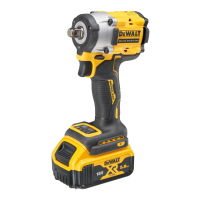
